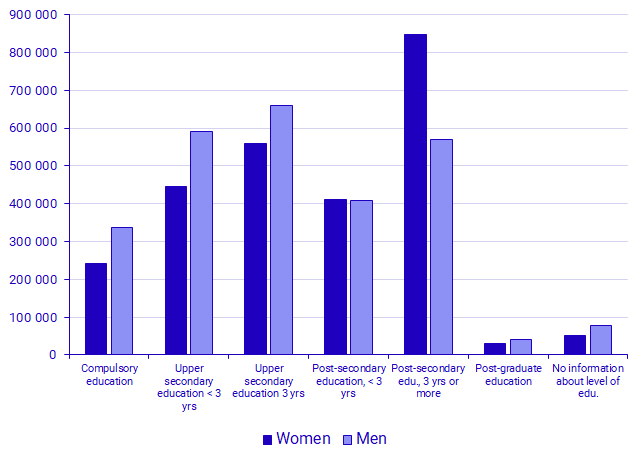Educational attainment of the population in 2019
Highest level of education among women and in university towns
Statistical news from Statistics Sweden 2020-05-08 9.30
Metropolitan municipalities, county seats and municipalities with a university have the largest number of highly educated persons. Women are more highly educated than men, but more men than women have a postgraduate education, according to new statistics on the educational attainment of the population in 2019.
Just over one quarter of the population is highly educated. These persons often live in metropolitan municipalities and county seats. The majority of the municipalities with the highest level of education are located in Stockholm County, where one third or more of the population in nine of the municipalities has at least three years of post-secondary education. Other municipalities with high levels of education include Lund, Lomma, Uppsala, Umeå and Linköping.
The high level of education in the Stockholm area is explained, to a large extent, by the many jobs located there in sectors with a high share of highly educated people, such as “financial and insurance activities”, “education” and “public administration and defence”. This area also offers a wide range of higher education and has a relatively young population, which has a higher formal level of education than the older population.
| Municipality | Share of inhabitants with at least a three year post-secondary education | Municipality | Number of inhabitants with at least a three year post-secondary education |
|---|---|---|---|
| Danderyd | 58% | Stockholm | 238 800 |
| Lund | 53% | Göteborg | 118 800 |
| Lomma | 50% | Malmö | 64 700 |
| Lidingö | 47% | Uppsala | 50 100 |
| Solna | 47% | Lund | 33 100 |
| Täby | 45% | Linköping | 31 800 |
| Stockholm | 42% | Umeå | 26 400 |
| Uppsala | 42% | Örebro | 23 200 |
| Sollentuna | 41% | Solna | 23 200 |
| Nacka | 40% | Västerås | 22 700 |
In most counties, the share of highly educated persons is significantly higher in the county seat and metropolitan areas than in other municipalities in the county. Among just less than half of the smaller municipalities (fewer than 5 000 inhabitants aged 25–64 years) the share of inhabitants with compulsory education as the highest level of education completed is higher than the share of those with post-secondary education, 3 years or longer.
A presentation of all municipalities’ educational levels is available on Statistics Sweden’s website and in the Statistical Database:
Educational attainment of the population
Approximately 1.5 million highly educated persons in Sweden
In the population aged 25–64, 44 percent have some form of post-secondary education. Just over one fourth, 28 percent, have at least three years of post-secondary education, which corresponds to 1 487 000 persons. The share of highly educated persons has increased in recent years by slightly more than 0.5 percentage point per year. The share of highly educated persons is roughly the same among Swedish born persons and among foreign born persons.

Young women have highest level of education
Women have a higher educational level than men. More women than men have post-secondary education and fewer only have compulsory education. However, there are still more men than women with a postgraduate education. Among those with a postgraduate education aged 25–64, 44 percent are women. However, in 2019, there are more women than men among first time postgraduate students for the first time.
Among women aged 25–44, more than half have a post-secondary education. There are 40 percent highly educated women, while barely one quarter of the men in the same age group are highly educated. This difference is due to the fact that more women continue to higher education. Currently, women account for 61 percent of persons enrolled in Swedish universities.
Statistical Database
More information is available in the Statistical Database
Feel free to use the facts from this statistical news but remember to state Source: Statistics Sweden.
